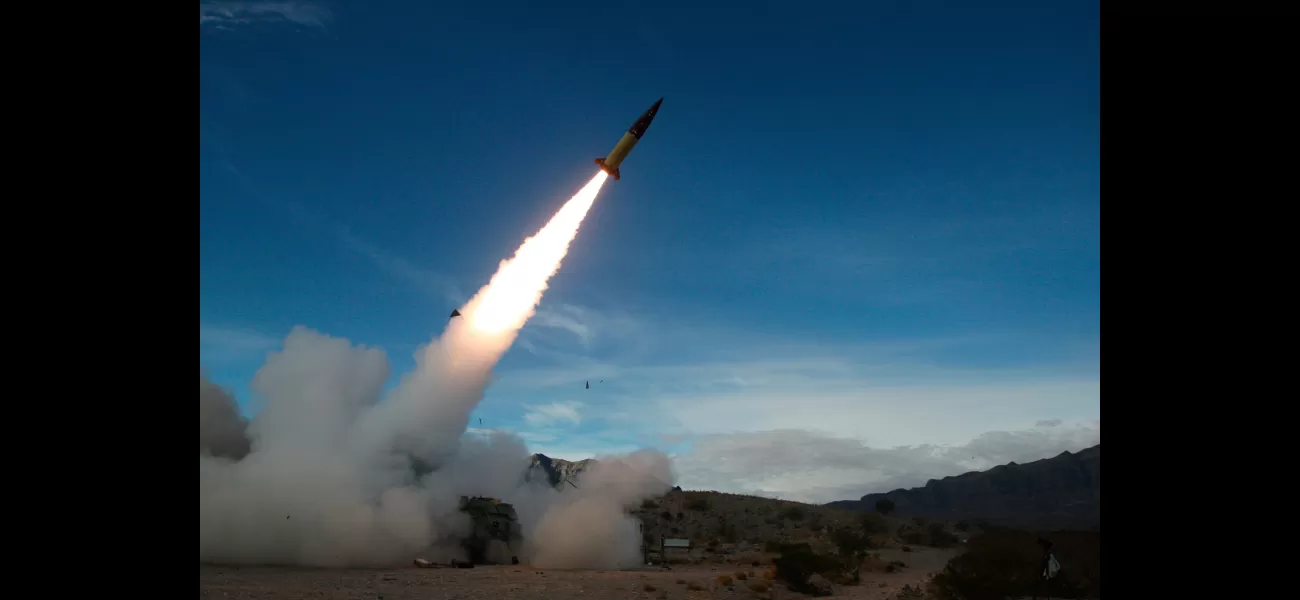Ukrainian soldiers are hopeful that continued use of U.S. weapons will have a significant impact inside Russia.
Ukraine is effectively stopping Russia's advance in the northeast, with the use of U.S. weapons, but military leaders want permission to use long-range missiles.
June 22nd 2024.

In the Kharkiv region of Ukraine, a recent decision has allowed the country to use weapons provided by the U.S. to launch limited strikes in Russian territory. This has proven to be effective in stopping Russia's new push along the northeast front, but military commanders are now pushing for the lifting of restrictions on long-range missiles.
The deteriorating conditions on the battlefield forced the U.S. to permit Ukraine to use Western-supplied artillery and rocket systems to defend the city of Kharkiv. By targeting border regions where Russian forces assemble and launch attacks, Ukrainian forces were able to push back the enemy, giving them time to fortify their own positions and even launch small offensive actions.
However, commanders are now saying that without the ability to use long-range guided missiles, such as ATACMS, they are limited in their actions. One artillery commander, who goes by the callsign Hefastus, explained that these missiles would allow them to target key command points and the entire northern grouping of Russian forces, which are located 100 to 150 kilometers from the front line. He emphasized that normal ammunition cannot reach these targets, but with ATACMS, they could inflict significant damage.
In interviews, the Ukrainian commanders requested to use their callsigns in accordance with brigade rules. The U.S. recently expanded the scope of their policy, allowing counterstrikes across a wider region. However, they have not yet lifted the restrictions on Ukraine to use ATACMS to strike inside Russian territory. According to three U.S. officials who spoke on condition of anonymity, the Biden administration is still hesitant to make this change, despite starting to provide Ukraine with these long-range missiles earlier this year.
This limitation prevents Ukrainian forces from attacking important targets such as airfields and military infrastructure in Russia's deep rear. This has been a source of frustration for Ukrainian officials, who believe that Western allies are more concerned about provoking Russia than supporting Ukraine's ability to effectively fight back.
Some Ukrainian officials are now calling for the lifting of these restrictions, specifically to use ATACMS to target high-value military targets inside Russia. Yehor Cherniev, the deputy chairman of the parliamentary committee on national security, defense, and intelligence, stated that they are unable to reach key targets, such as airfields and aircraft, due to these limitations.
Since late May, Ukrainian forces have been able to target Russian troops and air defense systems within 20 kilometers of the border in the Kharkiv region. This has greatly slowed Russia's momentum, allowing Ukrainian troops to make advances along the northeast border. Recent reports even claim that Ukrainian forces have recaptured areas southwest of Vovchansk, thanks in part to the use of high mobility army rocket systems, or HIMARS, which were fired just hours after receiving permission.
Hefastus recalled the first day they were able to use these rockets, stating that they were able to destroy entire columns of Russian troops waiting to enter Ukraine. He also noted that before this, they were unable to target these troops due to their location beyond the range of their weapons.
The use of these rockets immediately shifted the dynamics on the front line, stabilizing the situation in that part of the region. Soldiers near a strategic area north of Kharkiv, where fighting to push back Russian troops is ongoing, reported that enemy forces have moved back several kilometers. However, these claims could not be independently verified.
According to Kalina, a platoon commander for the Khartia Brigade, the use of these rockets has changed their tactics. Before, they were only able to target incoming infantry assaults, but now they can use more artillery against Russian firing points.
The U.S. decision to allow self-defense strikes in Russian territory came at the 11th hour, after much lobbying by Ukrainian officials. Ukrainian officials are now hoping to convince American allies to allow the use of ATACMS against specific targets.
Lys Mykyta, the commander of a drone company in the 103rd Territorial Defense Brigade, expressed frustration at the current situation. He stated that while the enemy is continuously launching missiles and attacks on Ukrainian territory, they are unable to strike back inside Russian territory where the enemy holds their logistics and supplies.
However, Ukrainian officials believe that it will take desperate battlefield conditions for the U.S. to consider lifting the restrictions. The recent invasion of the Kharkiv region by Russian forces, which required Ukrainian reserves to be called in, may have been a factor in the U.S. decision to allow self-defense strikes. Cherniev stated that he hopes the decision to lift the restrictions on ATACMS will be made soon, based on the situation on the ground.
The deteriorating conditions on the battlefield forced the U.S. to permit Ukraine to use Western-supplied artillery and rocket systems to defend the city of Kharkiv. By targeting border regions where Russian forces assemble and launch attacks, Ukrainian forces were able to push back the enemy, giving them time to fortify their own positions and even launch small offensive actions.
However, commanders are now saying that without the ability to use long-range guided missiles, such as ATACMS, they are limited in their actions. One artillery commander, who goes by the callsign Hefastus, explained that these missiles would allow them to target key command points and the entire northern grouping of Russian forces, which are located 100 to 150 kilometers from the front line. He emphasized that normal ammunition cannot reach these targets, but with ATACMS, they could inflict significant damage.
In interviews, the Ukrainian commanders requested to use their callsigns in accordance with brigade rules. The U.S. recently expanded the scope of their policy, allowing counterstrikes across a wider region. However, they have not yet lifted the restrictions on Ukraine to use ATACMS to strike inside Russian territory. According to three U.S. officials who spoke on condition of anonymity, the Biden administration is still hesitant to make this change, despite starting to provide Ukraine with these long-range missiles earlier this year.
This limitation prevents Ukrainian forces from attacking important targets such as airfields and military infrastructure in Russia's deep rear. This has been a source of frustration for Ukrainian officials, who believe that Western allies are more concerned about provoking Russia than supporting Ukraine's ability to effectively fight back.
Some Ukrainian officials are now calling for the lifting of these restrictions, specifically to use ATACMS to target high-value military targets inside Russia. Yehor Cherniev, the deputy chairman of the parliamentary committee on national security, defense, and intelligence, stated that they are unable to reach key targets, such as airfields and aircraft, due to these limitations.
Since late May, Ukrainian forces have been able to target Russian troops and air defense systems within 20 kilometers of the border in the Kharkiv region. This has greatly slowed Russia's momentum, allowing Ukrainian troops to make advances along the northeast border. Recent reports even claim that Ukrainian forces have recaptured areas southwest of Vovchansk, thanks in part to the use of high mobility army rocket systems, or HIMARS, which were fired just hours after receiving permission.
Hefastus recalled the first day they were able to use these rockets, stating that they were able to destroy entire columns of Russian troops waiting to enter Ukraine. He also noted that before this, they were unable to target these troops due to their location beyond the range of their weapons.
The use of these rockets immediately shifted the dynamics on the front line, stabilizing the situation in that part of the region. Soldiers near a strategic area north of Kharkiv, where fighting to push back Russian troops is ongoing, reported that enemy forces have moved back several kilometers. However, these claims could not be independently verified.
According to Kalina, a platoon commander for the Khartia Brigade, the use of these rockets has changed their tactics. Before, they were only able to target incoming infantry assaults, but now they can use more artillery against Russian firing points.
The U.S. decision to allow self-defense strikes in Russian territory came at the 11th hour, after much lobbying by Ukrainian officials. Ukrainian officials are now hoping to convince American allies to allow the use of ATACMS against specific targets.
Lys Mykyta, the commander of a drone company in the 103rd Territorial Defense Brigade, expressed frustration at the current situation. He stated that while the enemy is continuously launching missiles and attacks on Ukrainian territory, they are unable to strike back inside Russian territory where the enemy holds their logistics and supplies.
However, Ukrainian officials believe that it will take desperate battlefield conditions for the U.S. to consider lifting the restrictions. The recent invasion of the Kharkiv region by Russian forces, which required Ukrainian reserves to be called in, may have been a factor in the U.S. decision to allow self-defense strikes. Cherniev stated that he hopes the decision to lift the restrictions on ATACMS will be made soon, based on the situation on the ground.
[This article has been trending online recently and has been generated with AI. Your feed is customized.]
[Generative AI is experimental.]
0
0
Submit Comment





